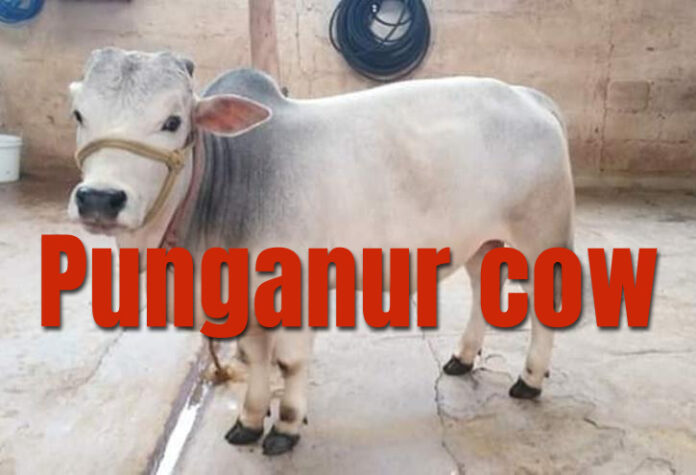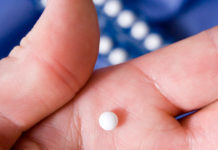Punganur Cattle is one of the world,s smallest Bos indicus cattle originated in Punganur town in Chittoor district of Andhra Pradesh. This Punganur cattle breed named after the village Punganur in Chittoor district, Andhra Pradesh, in the southern point of Deccan plateau. This breed milk high-fat content and rich in medicinal properties.
This breed is known for its short stature, high milk production efficiency and efficient reproductive characters. The Jamindars of Punganur were erstwhile Diwans in the Princely state of Mysore. They took fancy on this small breed of cattle and improved this breed and got the name as Punganur breed of cattle. These animals were found in the taluks of Palamaner, Madanapalli, Vayalpad, Piler and Chandragiri. However the breed is on the verge of extinction due to extensive indiscriminate crossbreeding over a period of time in breeding tract. Attempts are made to rescue the breed at Livestock Research Station, Palamaner, under Sri Venkateswara Veterinary University. Under the ICAR adhoc scheme on the Preservation and improvement of Punganur breed of cattle.The Punganur cattle which is also known as Punganur dwarf cattle originated from the Chitoor district of Andhra Pradesh in southern India. The breed is among the world’s smallest humped cattle breeds.
It is named after the town of it’s origin, Punganur, in Chittor district situated in the south-eastern tip of the Deccan Plateau.
The Punganur cattle breed is on the verge of extinction, with a few animals remaining. And these remaining animals are being reared mainly on the Livestock Research Station, Palamaner, Chittoor district, attached to SV Veterinary University.
The breed is not officially recognized as a breed since there are only a few animals remaining. Punganur cattle are mainly noted for their very high quality milk which is rich in medicinal properties. Today the breed is pretty rare. Read more information about this breed below.
Punganur Cattle Characteristics:
————————————–
Body: Punganur is one of very few smallest cattle breed in the world. Back sloping downwards from front to hindquarters, Tail touching the ground.
Body colour: Punganur cattle will be in different colours. White colour mixed with red, brown or black coloured patches are also seen.
Horns: Punganur breed has a broad forehead and short horns. The horns are crescent-shaped and often lose curving backwards and forward in males and lateral and forward in females.
Production traits: Average milk yield of the breed is 546 Kg per lactation, with 5% average milk fat.
Ability as draught purpose: The bullocks are used for agricultural operation in the light soil as well as for driving carts for transportation and special races.
Anything else: Normally Cow Milk has a fat content of 3 to 3.5 per cent, the Punganur breed’s milk contains up to 8 per cent.
Tirumala Tirupati Devasthanams (TTD) has about 200 Punganur cows in its cattle-yard. Ghee prepared from the milk of these cows is being used in ‘archana’ (offering) for Lord Venkateswara.
Punganur cow’s milk is used for ksheera abhishekam in Thirupathi for Venkateswara swami. The ghee of punganur cows is used for making the very famous Tirupathi temple laddu. The darshan of this cow itself is very sacred.
The native virgin Punganur breed cattle became almost an endangered species. The AP government is planning to launch Mission Punganur. Chief Minister YS Jagan Mohan Reddy also directed the officials concerned to take necessary steps to protect the native breed including Punganur and Ongole cattle varieties. The Punganur cattle fall under the Zebu category in scientific terminology. The cattle are drought resistant, short variety, a cow gives around 700 to 750 litres of milk over a lactating period, most of the people believe that its milk has lots of medicinal values.
At present, there are only around 200 known cows and bulls of our local variety virgin Punganur breed available, said Poonam Malakondaiah, Special Chief Secretary, Animal Husbandry department, speaking to the media. She further explained that the breed gives good quality milk and the mortality rate is very less. The Punganur cow’s milk has many medicinal values, the cow dung is highly useful for those adopting Zero Budget Natural Farming (ZBNF). The cow dung serves as a rich fertiliser source and its urine is being used for pest control in agriculture.
When we came to know the population of Punganur cows, we were surprised. The population of Ongole cattle currently is about 10,000 while that of Punganur cattle is only 200. There are some mixed and cross variety of Punganur cows available. But, the focus is on developing original breed,” she explained. Dr G Gangaraju, Principal Scientist and Head at Livestock Research Station (LRS), Palamaner said that the Punganur cattle’s dung and urine are rich sources of fertiliser and pest controller for organic farming.
The production also increased from 20 to 30 per cent in organic farming. It has already been proved in Punganur and surrounding areas. Since 2015, cow’s urine and dung are being used for ZBNF. The farmers said that there was an improvement in the quality of products and an increase in yield. The shelf life of the product also increased after using manure. It has so far been used in floriculture and horticulture. Gangaraju said that they have been rearing the Punganur cattle at the LRS. Poonam Malakondaiah said, “Under the Mission Punganur programme, the government will increase the population of the cattle. IVF technology, genome technology and vaccines production technology will be introduced for these cattle at AP Centre for Advanced Research on Livestock (APCARL) located at Pulivendula in Kadapa.” She further added that the developed cattle will be distributed to farmers under the ‘Polam Badi’ programme.
These cows are a blend of white and light grey. Their broad forehead and short horns add to their unique and endearing look. The average height of a Punganur is 70-90cm and it weighs 115-200kg.
Punganur cows are highly drought resistant – they can survive on dry fodder.
The body language of this cow is similar to a deer – it has a beautiful walking style. This breed, which is on the verge of extinction, has only around 300 odd cows remaining on our planet.
Punganur cattle are smaller sized animals and are white and light grey in color. Sometimes they can also be light brown to dark brown or red in color.
They have a broad forehead and short horns. Their horns are crescent shaped and often loose curving backward and forward in bulls and lateral and forward in cows.
Average height of the Punganur cattle is about 70-90 cm. The bulls on average weight around 225 kg. And average body weight of the cows is around 115 kg.
Main characteristics:
__________________
– Back slopes downwards from front to hind quarters
– Tail touches the ground
– Slight mobile horns and almost flat along the back
Uses:
____________
The Punganur cattle are mainly used for milk production. Their milk contain high fat content and rich in medicinal properties.
Punganur cattle are very hardy animals. They are well known for their quality milk production. Their milk has a high fat content compared to the milk of other cattle breeds. Generally, cow’s milk has 3 to 5 percent of fat content.
But Punganur cow’s milk contains about 8 percent of fat content. The breed is highly drought resistant and can survive on dry fodder. The cows on average can produce about 3-5 kg of milk per day.
And they have a daily feed intake of 5 kg. This breed yields an average of 3-5liters of milk per day and requires a daily feed intake of 5kg. The Punganur’s milk is high in fat content.
On an average, the milk from a normal cow has fat content ranging from 3% -3.5% fat; the Punganur milk contains 8% fat and is highly rich in medicinal properties.
Review full breed profile of this breed in the following chart.
Breed Name Punganur
Other Name Punganur Dwarf Cattle
Breed Purpose Milk
Special Notes Strong, hardy, drought resistant
Breed Size Small
Bulls Around 225 kg
Cows Around 115 kg
Climate Tolerance All Climates
Coat Color Mainly white and light grey in color
Horned Yes
Milk Yield Good
Rarity Rare
Country/Place of Origin India
About:
The Punganur cow is considered to be one of the world’s smallest breeds of cattle.
It has a height of 70 cm to 90 cm and weighing around 115 to 200 kg. In comparison, the famous Ongole bull stands tall at 1.70 metres and weighs 500 kg. Both breeds trace their origins to Andhra Pradesh.
Cultural Significance:
__________________
The Punganur cow has become a status symbol in recent years as wealthy livestock farmers began buying it, believing it brings good luck.
The Tirumala Tirupati Devasthanams (TTD) also has several Punganur cows, whose milk is used to prepare ghee which is offered as ‘archana’ to Lord Venkateswara.
Vulnerability:
The Food and Agriculture Organisation (FAO) lists the breed as facing extinction.
According to livestock journals, it is on the verge of extinction due to cross-breeding being conducted by farmers.


















































